Induction heating boiler do-it-yourself: theoretical basis
Does the induction heat carrier heating scheme have any real advantages? How economical is it compared to heating elements? How does an induction boiler? Is it possible to assemble it yourself? Let's try to answer these questions.
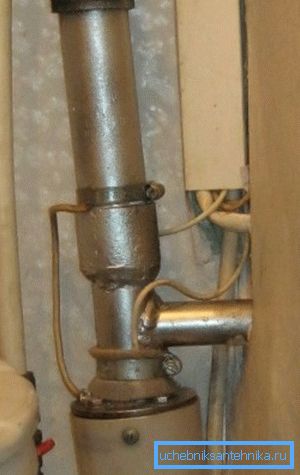
What it is
The essence of the phenomenon of electromagnetic induction, discovered by Michael Faraday in 1831, is that an electric current is excited in a conductor placed in a magnetic field. The effect, in particular, formed the basis of the principle of operation of any modern transformer.
If two insulated windings are wound onto a ferromagnetic core and apply to one of them, say, 220 volts, then the second will cause a voltage related to this 220 volts just as the number of turns of the secondary winding refers to the number of turns of the primary.
From the windings of the transformer, you can remove the voltage with the necessary characteristics and use it to operate the electric motor or electronics. But what if you put a ferromagnet that is not connected to anything in the winding-generating winding?
Obviously, the resulting EMF (electromotive force) is completely converted into the kinetic energy of motion of its molecules. Simply put - in the heat.
Reference: this is how induction cookers and melting furnaces work in steel mills.
Come on. What if you put a ferromagnetic core in a stream of water moving in a closed loop? Obviously, the water will cool it and heat itself.
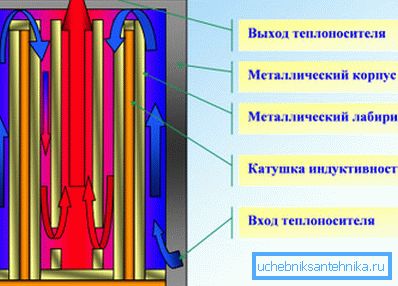
Thus, at the outlet we get a finished electric boiler for the dacha heating.
One has only to solve a few technical problems:
- Choose a core of non-corrosive material.
- Isolate it from the coil, while ensuring the integrity of the structure.
- Make so that the coil itself does not overheat when large currents pass through it.
Advantages of the induction circuit
As a rule, the price of factory-made induction boilers is, on average, noticeably higher than that of TEN's analogs, and starts from 20-25 thousand rubles with 4-kilowatt power of the device.
In order not to be unfounded, we present the parameters of several devices present in the Russian market.
| Model | Electric power, W | Cost, rubles | Manufacturer | Heating area |
| VIN-5 | 4250 | 27,000 | Russia | 60-150 |
| Indicator | 4,000 | 18,000 | Ukraine | 200 |
| Edison-5 | 5000 | 35,000 | Europe | 100-120 |
| INERA SAV | 4500 | 30,000 | Russia | 50-80 |
As a justification for the higher cost, manufacturers and sellers cite two arguments:
- Induction boiler is more durable compared to the Tenov analogue.
- It provides significant (up to 40-50%) electricity savings, what will allow expenses to pay off quickly.
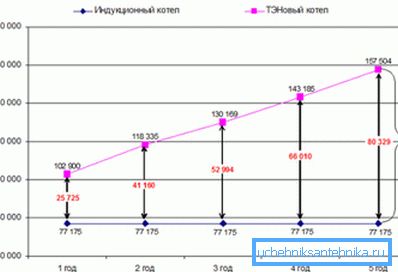
Let's try to evaluate the veracity of both statements.
Durability
Claims that the induction design is exceptionally fault tolerant and durable is the absolute truth.
The reasons?
- There are no moving parts in the boiler. If so - there is no mechanical wear of the structure.
- It is free from the main problem of heating elements - the liming of heating elements. Lime scale gradually heat-insulates tubular heaters and causes them to overheat.
It is curious: when excited in the core of an inductor of eddy currents, it vibrates subtly, which contributes to self-cleaning of the surface.
Efficiency
Let's remember the basics of physics.
- From the point of view of Sir Isaac Newton, the energy does not go anywhere and is not taken from anywhere. Perpetual motion is not possible; to heat a fixed volume of air at 10 degrees you need to spend a strictly defined amount of thermal energy, regardless of the heater design.

- For any transformation of energy of any type, it eventually either performs physical work (that is, moves an object with a non-zero mass against the gravity vector), or is used to heat the environment.
We emphasize: The efficiency of any electric device of direct heating is 100%.
All electricity consumed is completely converted to heat; 1 kW of electrical power can be obtained 1 kW of heat.
Thus, the only thing that could theoretically explain the supposedly higher efficiency of an induction boiler is less heat dissipation in the environment.
This argument does not hold water:
- When installing the boiler in a heated room, the heat that is not absorbed by the coolant is still consumed for heating.

- At 50% less heat loss with comparable or worse heat insulation of the boiler body look, to put it mildly, it is doubtful.
The conclusions are obvious:
- The market value of induction devices is wrongly high.
- Their economy - as one of the heroes of Bulgakov said, a typical case of the so-called lies. Electric power of the device is selected on the basis of standard 40 watts per cubic meter of heated room. Attempting to heat a 200-meter-long house with a 4-kilowatt device will lead only to the recent purchaser’s realization that he was too naive.

crazy hands
Despite the heaps of misinformation, the induction circuit itself is more than entitled to life. The inflated market value quite naturally leads to the idea to make induction heating boilers with your own hands. How to do it?
Housing
It should be:
- Dielectric.
- Strong enough.
- Allowing hermetically to connect it to the heating circuit.
The simplest and most obvious solution is a polypropylene pipe with a diameter of 40 millimeters. Ideally, with fiber reinforcement, which will have a very positive effect on the strength properties of the hull.
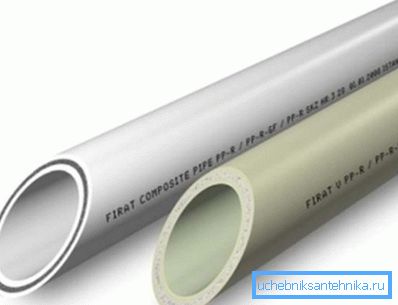
Winding
In order to isolate the inductance coil heating up from the thermoplastic polypropylene when energized, it is desirable to glue several textolite strips over the case. What to glue? The simplest and most obvious solution is silicone sealant: it has acceptable adhesion to plastics and is well tolerated by moderate heat.
An important point: it is better to take sealants from famous manufacturers (Ceresit, Moment, etc.). Cheap sealants differ from them in the first place by far worse adhesion to problematic surfaces, which, of course, includes the smooth wall of the polypropylene pipe.
The coil itself is wound with copper enameled wire with a diameter of about 1.5 millimeters (cross section 2.25 mm2). The total length of the winding should be 10-15 meters. The coils are best applied with a small constant gap.
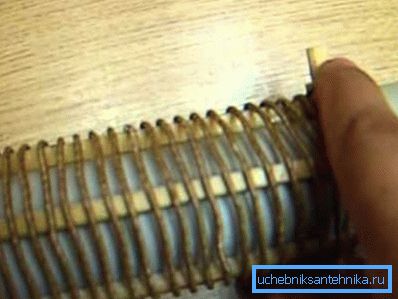
Core
What should it be?
- Conductive. Eddy currents will not be induced in the dielectric.
- Ferromagnetic. Diamagnetic will not interact with the electromagnetic field.
- Stainless. Corrosion in a closed heating circuit is clearly useless.
Here are some possible solutions.
- Screw auger, tightly fitting into the tube. Moving along the grooves in it, the water will take the maximum heat.
- Chopped stainless wire. It is not very convenient because the improvised boiler will have to be limited on both sides by a metal grid.
- Hedgehogs rolled up from nichrome wire, tightly inserted into the pipe.
- Finally, the simplest instruction: in the same way, metal (stainless) dishcloths can be placed in the pipe.
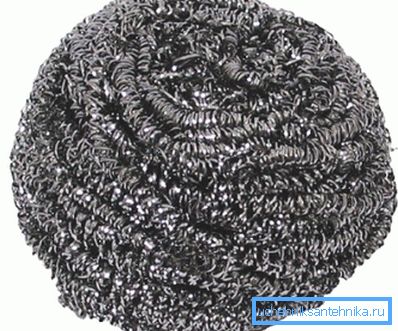
After the core has taken its place, the boiler is supplied on both sides with adapters from polypropylene with a diameter of 40 mm to DU20 or DU25 threads. They will not allow the core to fall out and allow the boiler to be mounted in any circuit, leaving the connections collapsible.
Power converter
What happens if you simply connect the inductor wound by us to the outlet?
Let's do a simple calculation.
- The resistivity of the copper conductor at + 20 ° С is 0.175 Ω * mm2 / m.
- With a cross section of 2.25 mm and a length of 10 meters, the total resistance of the coil will be equal to 0.175 / 2.25 * 10 = 0.7 Ohm.
- Therefore, when applied to a conductor of 220 volts, a current of 220 / 0.7 = 314 A will flow through it.
For comparison: when calculating the wiring for copper, the cross section is selected at the rate of 10 A / mm2.
The result is a bit predictable: when the current is supplied more than 10 times higher than the calculated one, our conductor will simply melt.
The obvious solution is to reduce the supply voltage. The converter must be powerful enough to give at least 2.5 - 3 kilowatts.
A finished inverter of such power can be a welding inverter with adjustable current. Adjustment not only saves the winding from overheating, but also allows you to smoothly adjust the effective power of the heating boiler. With an inverter output voltage of 80 volts, the maximum safe power for the winding temperature will be about 2 kW.

Costs
Of any significant costs, it is worth mentioning, perhaps, a welding inverter (from 6000 rubles) and a soldering iron for polypropylene (from 1000 rubles). Still a maximum of 1000 will fit all other purchases.
Conclusion
We hope that our recommendations will be useful to the reader. In the video attached to the article you can find additional information on the independent production of an induction boiler. Successes!